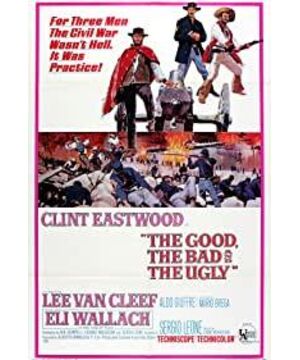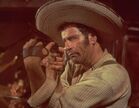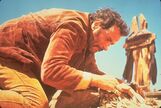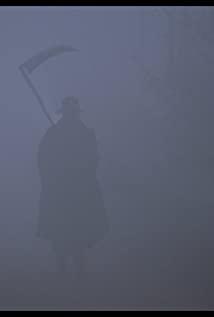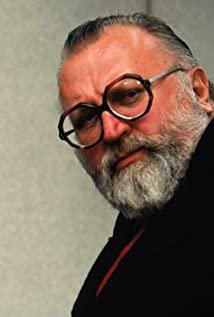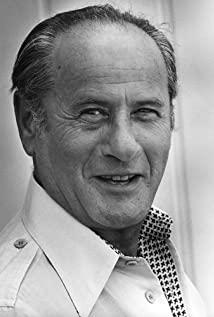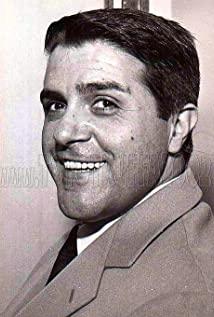The camera swept across the empty western land, and then the lens slid down on an exposed, lonely face. A big close-up shot from the perspective to the face, intended to reveal that this place is not really empty, but occupied by a desperado who is close at hand.
At the beginning of the film, Sergio Leoni implemented a lens criterion for "The Good, the Bad and the Ugly": seeing is not necessarily believing, and the presentation of content is restricted by the frame of the screen. At some important moments in the film, places outside the lens and invisible to the characters provide Leonne with creative freedom. His lens has also become the entrance to our accidental discoveries, and these accidents are often unreasonable.
For example, once, people did not notice the huge camp of the Federal Army at the beginning, but discovered it by accident. Another time in the cemetery, a person who should have been found a mile away seemed to have appeared out of thin air. The men walked on the street with full vision, but no one around them hit them, perhaps because the two groups of people were not in the same picture.
Leone doesn't care about actual things or flashy things. He is committed to turning waste into treasure with a personal artistic style, building his great movies on the ruins of clichéd Westerns. Shortly after the release of "Red Dead Redemption" (1964) and "Falling Night" (1965), at the end of 1967, the film was released in the United States. The audience knew they would like it, but do they know why?
I watched this film sitting in the front row of the box of the Oriental Theater, and its wide screen is ideal for watching Leone’s work. I remember my reaction was fierce. At that time, I was just a rookie who had just become a film critic for less than a year. Looking back at my old reviews, I realized that I was describing a four-star movie, but only gave it three stars, perhaps because it is a "Macaroni Western", it cannot be an art.
But it is indeed art. It is the art of Leone using his imagination to depict it on the wide screen. It is so vivid that we ignore the fact that it is only a small-cost production-Clint Yi Sturwood was Hollywood's abandoned son at the time; a series of errors caused by budget constraints (the Red Dead Redemption budget was only $200,000); there was not much dialogue, because it was more cost-effective to replace dubbing with sound effects. There are even useless attempts to make the film look more American. I learned from the critic Glenn Eriksson that Leonne was called "Bob Robertson" during the Red Dead Redemption period, and the composer Ennio Morricone was called "Dan Savio". "His lonely, sad soundtrack is an indispensable part of the film. Even the role of Eastwood, the famous "Unknown Guest", is also a product of publicity. In fact, his name in the first movie is Joe, the second is "Manco", and the third is "Brandy".
Perhaps its exotic flavor, especially a unique masterpiece like "The Good, the Bad and the Ugly" makes "Macaroni Westerns" different from the traditional westerns. Unlike the Hollywood model of routines, the actors in these films are all people from areas around Spain-these people have to go through a long period of exposure. Imagine a legless beggar pushing himself into a bar with his arm and shouting: "Bring me a glass of whiskey!"
John Ford made countless great movies in Monument Valley, and that place was his source of inspiration. However, the crisis-ridden Spanish look in Leone's movies gives people a sense of freshness and weirdness. We have never seen these deserts before. John Wayne has never been there. Leone’s story is a dream higher than reality, everything is bigger, more radical, more cruel, and more dramatic than life.
Leone’s story is more narrated in pictures than words. Come and see the wonderful confrontation scene in the cemetery. It is said that a treasure was buried in a certain grave, and three people gathered here, all wanting to get it. The three actors are Clint Eastwood (good), Lee Van Cleef (bad), and Eric Wallach (ugly) For "Good·Bad·Ugly"]. Everyone pointed a gun at another person, and no one dared to act rashly, otherwise everything would be harmed. Unless the two of them unite to deal with the third person and kill him before the latter shoots. But which two are combined, and who is the one left?
Leoni focused on this irrational scene, starting from the details, first with a long shot, followed by close-ups such as guns, faces, eyes, a lot of sweat, and flies. He seems to be testing himself just to see how long he can maintain this suspense. Or is it a suspense? It may be a completely stylized attempt, deliberately done by the director, with the intention of focusing on itself. If you can taste the courage of parody, then you can understand Leoni's expression. This is not a story, but a celebration of skill.
Eastwood was 34 years old when he first worked with Leone, and now he is an authority among them. The fact is that he was born in a TV series and once starred in "The Whip". At that time, the thinking of an ordinary moviegoer was that it was not worth spending money to watch actors who could be seen on TV for free. Eastwood defeated bad luck, but not everyone can do it—nor can it be done with any director. Talking about the collaboration with Leonne, his explanation was that he wanted to make a movie, and Hollywood rejected him.
This is true, but Eastwood himself has become an important director, and even he must have felt that Leonne is not only an ordinary Italian popular film director, but also a passionate person. The "Unknown Guest" created by Lionel and Eastwood together, its weight not only surpasses a certain TV star, but also surpasses a certain movie star-a person who never needs explanation, just depends on his boots, Fingers and eyes are enough to fill the entire screen of a person.
I wonder if Eastwood’s dialogue is one-tenth of Eri Wallach (played by Tuco). The "unknown guest" never speaks; Tuco talks endlessly. Tuco's performance was a creative play by Wallach. He tried his best to avoid letting the character fall into an absurd situation, and instead made it look desperate and fearful. When he acted as a harlequin, we felt that he did it intentionally, not by nature. As an old opera bone with long-term stage performance experience, Wallach takes this "low-end" role seriously and discovers the depth behind it.
"Angel Eye" Lee Van Cleef was born in New Jersey and has appeared in 53 movies and countless TV shows, many of which are westerns (his famous film is "Noon", in which he played a part of the gang member). His squinted eyes in the film reveal a crazy obsession.
All three of them are looking for the gold lost in the civil war, and their hiding information is scattered among the three (one only knows the cemetery but not the name of the tombstone, and the other only knows the name of the tombstone but not the cemetery). So they will be in peace until they find the tomb, but the next thing is likely to be a killing of each other.
In its 180-minute restored version, the plot is not complicated, but this is not to say that León lacks ideas. It has outdoor shootout scenes involving multiple people. There was a collusive scam, Eastwood turned in the wanted man played by Wallach to earn a bounty. When the latter was about to be hanged, Eastwood used his superb marksmanship to break the rope. . There is a set of magnificent desert shots, during which Eastwood abandoned Wallach alone in the desert, and then Wallach did the same thing to Eastwood. The sun burned like a scene in "Greed" NS. There was also a ghost van that was out of control, full of dead people.
In addition, what is surprising is that the film has a set of very ambitious civil war scenes, which can be called a play in the play. It focuses on a lieutenant of the Federal Army (played by Aldo Gufferi) and brings up the depiction of the entire war scene. , This person has a lot of rhetoric about his alcoholism: a commander who does not drink before the battle is not a good commander, and he wins by drinking. His last words are: "Can you let me live a little longer? I want to hear good news."
Sergio Leone (1929-1989) is a visionary and ambitious director, although he is also good at managing himself, just as he created the "Macaroni Western". Glenn Erickson wrote an article about the trilogy (available at www.DVDtalk.com ), mentioning that Leonne likes to exaggerate his resume, such as his claim to be Robert Aldridge’s The assistant director of "City Record" (1962), but in fact he was fired after only staying for one day. Leone made a forgotten epic of the Roman Empire in 1961, and in the same year he remakes "Red Dead Redemption" based on Akira Kurosawa's "Intentional Stick". It seems that Gus Van Sant was right There is a precedent for the frame-by-frame remake of "The Terror" ("98 The Terror").
As an ambitious director, Leone has shot two unquestionable masterpieces-"Once Upon a Time in the West" (1968) and "Once Upon a Time in America" (1984). In the late years of his career, Hollywood criminally cut "Once Upon a Time in America" from 227 minutes to 139 minutes because of concerns that his film was too long. "The Good, the Bad and the Ugly" has also been cut for 19 minutes. Fortunately, his uncut version of the film has been preserved in the form of DVD, and time has proved how good he is.
original:
A vast empty Western landscape. The camera pans across it. Then the shot slides onto a sunburned, desperate face. The long shot has become a closeup without a cut, revealing that the landscape was not empty but occupied by a desperado very close to us .
In these opening frames, Sergio Leone established a rule that he follows throughout "The Good, the Bad and the Ugly." The rule is that the ability to see is limited by the sides of the frame. At important moments in the film, what the camera cannot see, the characters cannot see, and that gives Leone the freedom to surprise us with entrances that cannot be explained by the practical geography of his shots.
There is a moment, for example, when men do not notice a vast encampment of the Union Army until they stumble upon it. And a moment in a cemetery when a man materializes out of thin air even though he should have been visible for a mile . And the way men walk down a street in full view and nobody is able to shoot them, maybe because they are not in the same frame with them.
Leone cares not at all about the practical or the plausible, and builds his great film on the rubbish of Western movie cliches, using style to elevate dreck into art. When the movie opened in America in late 1967, not long after its predecessors "A Fistful of Dollars" (1964) and "For a Few Dollars More" (1965), audiences knew they liked it, but did they know why?
I saw it sitting in the front row of the balcony of the Oriental Theatre, whose vast wide screen was ideal for Leone's operatic compositions. I responded strongly, but had been a movie critic less than a year, and did not always have the wisdom to value instinct over prudence. Looking up my old review, I see I described a four-star movie but only gave it three stars, perhaps because it was a "spaghetti Western" and so could not be art.
But art it is, summoned out of the imagination of Leone and painted on the wide screen so vividly that we forget what marginal productions these films were--that Clint Eastwood was a Hollywood reject, that budgetary restraints ($200,000 for "Fistful") caused gaping continuity errors, that there wasn't a lot of dialogue because it was easier to shoot silent and fill the soundtrack with music and effects. There was even a pathetic attempt to make the films seem more American; I learn from the critic Glenn Erickson that Leone was credited as "Bob Robertson" in the early prints of "Fistful," and composer Ennio Morricone, whose lonely, mournful scores are inseparable from the films, was "Dan Savio." Even Eastwood's character, the famous Man With No Name , was an invention of the publicists;he was called Joe in the first movie, Manco in the second, and Blondie in the third.
Perhaps it is the subtly foreign flavor of the spaghetti trilogy, and especially the masterpiece "The Good, the Bad and the Ugly," that suggests the films come from a different universe than traditional Westerns. Instead of tame Hollywood extras from central casting, we get locals who must have been hired near the Spanish locations--men who look long-weathered by work and the sun. Consider the legless beggar who uses his arms to propel himself into a saloon, shouting, "Hand me down a whiskey!"
John Ford made Monument Valley the home turf of his Western characters, and he made great films there, but there is something new and strange about Leone's menacing Spanish vistas. We haven't seen these deserts before. John Wayne has never been here. Leone's stories are a heightened dream in which everything is bigger, starker, more brutal, more dramatic, than life.
Leone tells the story more with pictures than words. Examine the masterful scene in the cemetery. A fortune in gold is said to be buried in one of the graves, and three men have assembled, all hoping to get it. The actors are Clint Eastwood (the Good), Lee Van Cleef (the Bad), and Eli Wallach (the Ugly). Each man points a pistol at the other. If one shoots, they all shoot, and all die. Unless two decide to shoot the third man before he can shoot either one of them. But which two, and which third?
Leone draws this scene out beyond all reason, beginning in long shot and working in to closeups of firearms, faces, eyes, and lots of sweat and flies. He seems to be testing himself, to see how long he can maintain the suspense. Or is it even suspense, really? It may be entirely an exercise in style, a deliberate manipulation by the director, intended to draw attention to itself. If you savor the boldness with which Leone flirts with parody, you understand his method. This is not a story, but a celebration of bold gestures.
Eastwood, 34 when he first worked with Leone, already carried unquestioned authority. Much is made of the fact that he came from television, that he starred in "Rawhide," that in those days it was thought that a movie audience wouldn't pay to see an actor it could watch for free. Eastwood overcame that jinx, but not any actor could have done it--and not with any director. He says he took the roles with Leone because he wanted to make movies and Hollywood wouldn't hire him.
Yes, but Eastwood himself was to become an important director, and even then he must have sensed in Leone not just another purveyor of the Italian sword-and-sandal epics, but a man with passion. Together, Leone and Eastwood made The Man With No Name not simply bigger than a television star, but bigger than a movie star--a man who never needed to explain himself, a man whose boots and fingers and eyes were deemed important enough to fill the whole screen.
I wonder if Eastwood's character has a tenth as much dialogue as Tuco, the Eli Wallach character. The Man With No Name never talks; Tuco never stops. This is one of Wallach's inspired performances, as he sidesteps his character's potential to seem ridiculous, and makes him a desperate, frightened presence. When he makes a clown of himself, we sense it is Tuco's strategy, not his personality. Trained in the Method, a stage veteran, Wallach took this low-rent role seriously and made something evocative out of it.
Lee Van Cleef, as Angel Eyes, was New Jersey-born, already a veteran of 53 films and countless TV shows, many of them Westerns (his first movie credit was "High Noon," where he played a member of the gang). In a movie with a lot of narrowed eyes, he has the narrowest, and they gleam with insane obsession.
All three men are after the fortune in Civil War gold, and the secret of its location is parceled out among them (one knows the cemetery but not the grave, the other knows the name on the tombstone but not the cemetery). So they know that they will remain alive until the grave is found, and then it is likely that each of them will try to kill the others.
In a film that runs 180 minutes in its current restored version, that is not enough plot, but Leone has no shortage of other ideas. There is the opening shootout, involving unrelated characters. There is the con game in which Wallach plays a wanted man , Eastwood turns him in for the reward, and then Eastwood waits until he is about to be hanged and severs the rope with a well-aimed shot. There is the magnificent desert sequence, after Eastwood abandons Wallach in the desert, and then Wallach does the same to Eastwood, and the sun burns down like a scene from "Greed." There is the haunting runaway wagon, filled with dead and dying men.
And, surprisingly, there is an ambitious Civil War sequence, almost a film within a film, featuring a touching performance by Aldo Giuffre as a captain in the Union Army who explains his alcoholism simply: the commander who has the most booze to get his troops drunk before battle is the one who wins. His dying line: "Can you help me live a little more? I expect good news."
Sergio Leone (1929-1989) was a director of boundless vision and ambition, who invented himself almost as he invented the spaghetti Western. Erickson, whose useful essay on the trilogy is at www.DVDtalk.com, notes that Leone hyped his own career "by claiming to be the assistant director on Robert Aldrich's Italian production of'Sodom and Gomorrah' (1962), even though he was fired after only a day." Leone made a forgotten Roman Empire epic in 1961, and then based "A Fistful of Dollars" so closely on Akira Kurosawa's samurai film "Yojimbo" that perhaps Gus Van Sant's shot-by-shot remake of "Psycho" (1998) was not the first time the technique was tried.
A man with no little ideas, Leone made two other unquestioned masterpieces, "Once Upon a Time in the West" (1968) and "Once Upon a Time in America" (1984). By the end of his career, Hollywood was suspicious of films with long running times, and criminally chopped "America" from 227 minutes to a sometimes incomprehensible 139. Nineteen minutes were cut from the first release of "The Good, the Bad and the Ugly." But uncut versions of all of his films are available on DVD, and gradually it becomes clear how good he really was.
WeChat public account: Suping
View more about The Good, the Bad and the Ugly reviews


